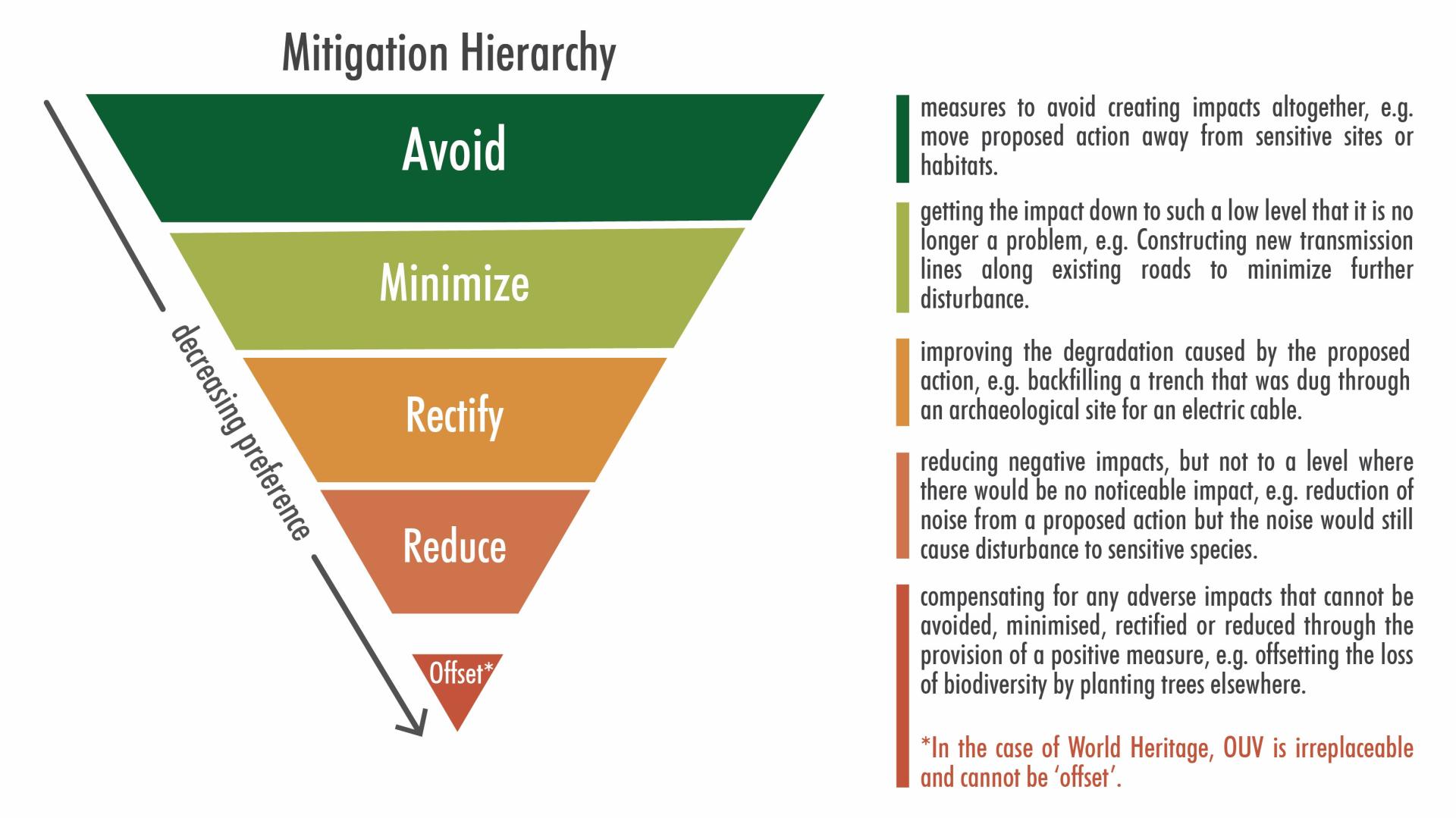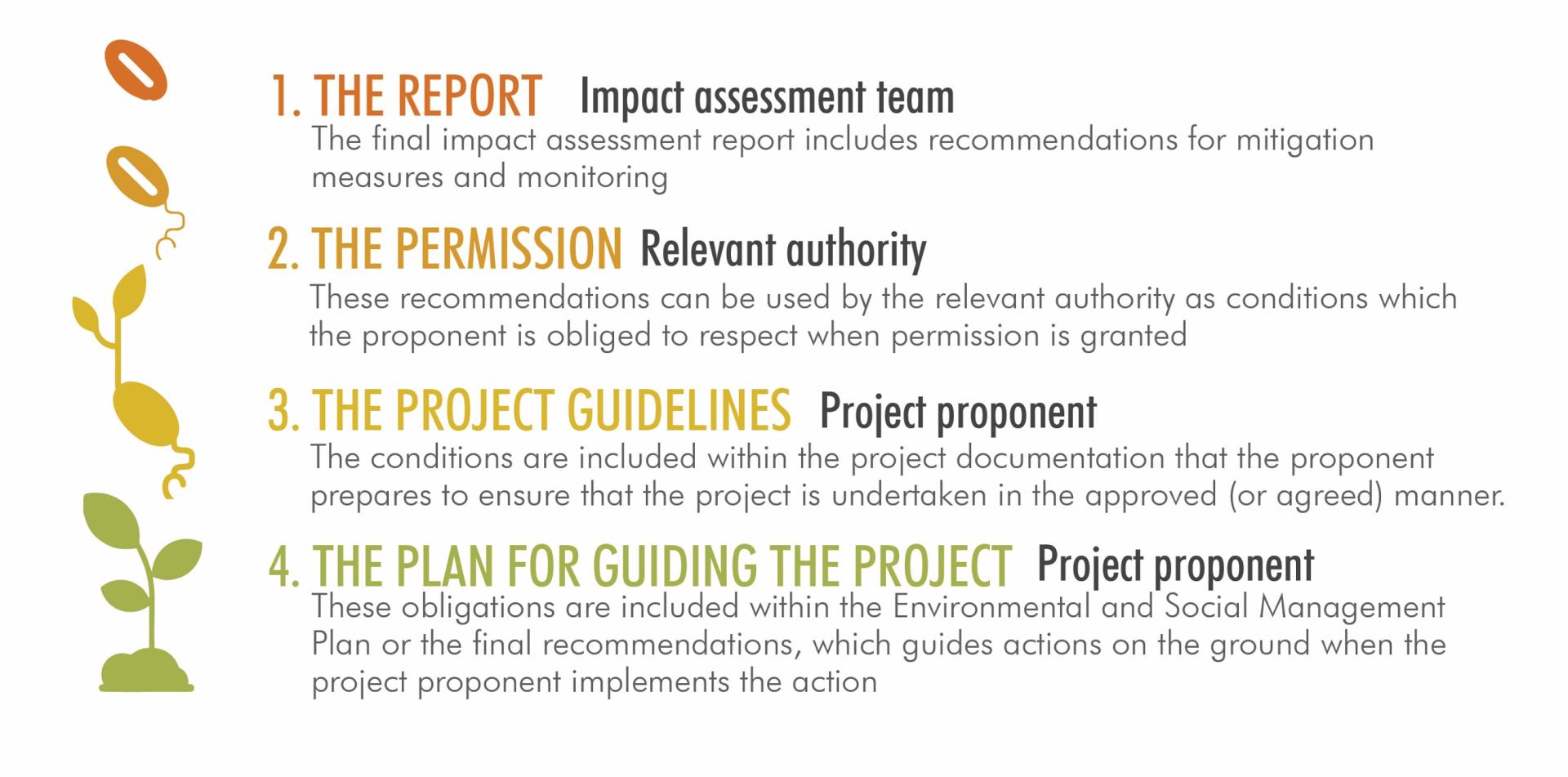Mitigation and engancement
6.10.1 Mitigating negative impacts
If impacts are negligible, they may need no mitigation. In all other cases, mitigation should be considered to avoid or minimize any negative impacts (Section 6.3), and the revised proposed action together with its mitigation measures needs to be re-assessed (Section 6.8). This makes impact assessment an iterative process, with final predictions that include the planned mitigation measures.
A ‘mitigation hierarchy’ is often used in impact assessment, ranging from the preferred ‘avoidance’, through ‘minimize’, ‘rectify’ and ‘reduce’ to ‘offset’ (Figure 6.10). However, in the case of World Heritage, OUV is irreplaceable and cannot be ‘offset’. The best outcome for World Heritage is to avoid negative impacts entirely – this includes the dismissal of the proposed action, or its relocation away from the
World Heritage property
A cultural, natural or mixed heritage place inscribed on the World Heritage List and therefore considered to be of OUV for humanity. The responsibility for nominating a property to the World Heritage List falls upon the State(s) Party(ies) where it is located. The World Heritage Committee decides whether a property should be inscribed on the World Heritage List, taking into account the technical recommendations of the Advisory Bodies following rigorous evaluation processes.
When used as a general term, World Heritage refers to all the natural, cultural and mixed properties inscribed on the World Heritage List.
. However, it may involve creative problem-solving to re-think and potentially redesign the proposed action or identify measures that avoid negative impacts. In some cases, it may not be possible to entirely avoid all negative impacts but they should be minimized to acceptable levels that cause no concern for World Heritage by significantly reducing their magnitude, duration, extent, etc.

Figure 6.10. The
Mitigation
By definition, mitigation is ‘the action of reducing the severity, seriousness or painfulness of something’. It aims to prevent negative impacts from happening and to keep those that do occur within an acceptable level. Mitigation measures are first identified and, as appropriate, adopted during project feasibility studies when considering alternatives and design options to avoid or reduce impacts. They then become part of the project implementation plan to address impacts that are expected to occur during construction, operation, decommissioning and closure. Mitigation can include both structural measures (e.g. design or location changes) and non-structural measures (e.g. institutional and policy instruments; provision of community services; and training and capacity building).
Where impact assessment typically explores a range of mitigation measures within a mitigation hierarchy (from avoidance to offsetting), not all of these options are appropriate in a World Heritage context. In fact, avoiding negative impacts entirely or minimizing them to acceptable levels are the only types of mitigation that should be considered.
Note that ‘mitigation’ usually applies to dealing with negative impacts. Projects may well also have positive impacts, especially if designed with preserving or enhancing biophysical or social values in mind.
Hierarchy.
Box 6.5. Examples of avoidance and minimization of negative impacts
Examples of avoidance of negative impacts include:
● Not undertaking a proposed action
● Selecting a different location or route away from the
World Heritage property
A cultural, natural or mixed heritage place inscribed on the World Heritage List and therefore considered to be of OUV for humanity. The responsibility for nominating a property to the World Heritage List falls upon the State(s) Party(ies) where it is located. The World Heritage Committee decides whether a property should be inscribed on the World Heritage List, taking into account the technical recommendations of the Advisory Bodies following rigorous evaluation processes.
When used as a general term, World Heritage refers to all the natural, cultural and mixed properties inscribed on the World Heritage List.
● Maintaining a buffer zone between (parts of) the proposed action and attributes
● Eliminating a particularly problematic element of the proposed action
Examples of minimization of negative impacts include:
● Reducing the scale of a proposed action
● Selecting a different location or route
● Reducing noise or vibrations from a proposed action to such a level that it does not cause
disturbance
● Redesigning elements of the proposed action
● Using different technologies
Once mitigation measures have been identified, it is important that they are included in the revised proposed action, which should then be re-evaluated. Any residual negative impacts – those impacts that would still affect the
World Heritage property
A cultural, natural or mixed heritage place inscribed on the World Heritage List and therefore considered to be of OUV for humanity. The responsibility for nominating a property to the World Heritage List falls upon the State(s) Party(ies) where it is located. The World Heritage Committee decides whether a property should be inscribed on the World Heritage List, taking into account the technical recommendations of the Advisory Bodies following rigorous evaluation processes.
When used as a general term, World Heritage refers to all the natural, cultural and mixed properties inscribed on the World Heritage List.
even after mitigation has taken place – then need to be addressed. Further mitigation measures may be needed. If significant residual negative impacts on OUV cannot be avoided, the impact assessment report should recommend that the proposed action should not be taken forward.
6.10.2 Providing/enhancing positive impacts
While avoiding negative impacts is at the heart of impact assessment, best practice in impact assessment takes a more proactive and positive approach: proponents should not only aim to ‘do no harm’, but seek to actively ‘do good’ while not compromising OUV. The commitment of
States Parties
The countries which have adhered to the Convention Concerning the Protection of the World Cultural and Natural Heritage (
World Heritage Convention
The Convention Concerning the Protection of the World Cultural and Natural Heritage is an international treaty adopted by the UN in 1972 that defines the kind of natural or cultural sites which can be considered for inscription on the World Heritage List for their Outstanding Universal Value for all humankind. Commonly known as the World Heritage Convention, it establishes how the international community as a whole is responsible for
the protection of such heritage and sets out the duties of States Parties in identifying potential sites that may be eligible for inscription onto the World Heritage List and their role in protecting and preserving them. By signing the Convention, each country pledges to conserve not only the sites situated on its territory that have been recognized as being of Outstanding Universal Value, but also to protect its national heritage and to be involved in international efforts to protect, conserve and promote the heritage of humankind.
) (UNESCO, 1972).
to integrate a sustainable development perspective into all World
Heritage
All inherited assets which people value for reasons beyond mere utility. Heritage is a broad concept and includes shared legacies from the natural environment, the creations of humans and the creations and interactions between humans and nature. It encompasses built, terrestrial, freshwater and marine environments, landscapes and seascapes, biodiversity, geodiversity, collections, cultural practices, knowledge, living experiences, etc.
processes (Section 3.4) means that impact assessment offers an opportunity to enhance the positive impacts of a proposed action, or create new ones, for the benefit of both heritage and society (see Box 6.6).
Box 6.6. Examples of enhancement of positive impacts
Examples of enhancement of positive impacts (where this does not impinge on OUV) include:
● Employing local residents, training them and involving them in the management of the project or
World Heritage property
A cultural, natural or mixed heritage place inscribed on the World Heritage List and therefore considered to be of OUV for humanity. The responsibility for nominating a property to the World Heritage List falls upon the State(s) Party(ies) where it is located. The World Heritage Committee decides whether a property should be inscribed on the World Heritage List, taking into account the technical recommendations of the Advisory Bodies following rigorous evaluation processes.
When used as a general term, World Heritage refers to all the natural, cultural and mixed properties inscribed on the World Heritage List.
● Enhancing biodiversity by linking ‘green’ areas via wildlife corridors
● Providing health, community or educational facilities in areas where these are needed
● Remediating contaminated land
● Removing inappropriate interventions such as unsympathetic building additions or impediments to significant views
● Improving human well-being and air quality through new parks and walking/cycling facilities
The proposed action may also be able to reduce the impact on the
World Heritage property
A cultural, natural or mixed heritage place inscribed on the World Heritage List and therefore considered to be of OUV for humanity. The responsibility for nominating a property to the World Heritage List falls upon the State(s) Party(ies) where it is located. The World Heritage Committee decides whether a property should be inscribed on the World Heritage List, taking into account the technical recommendations of the Advisory Bodies following rigorous evaluation processes.
When used as a general term, World Heritage refers to all the natural, cultural and mixed properties inscribed on the World Heritage List.
of external or cumulative changes and disasters. For instance, it may stabilize unsteady ground to reduce erosion at a geologically fragile
World Heritage property
A cultural, natural or mixed heritage place inscribed on the World Heritage List and therefore considered to be of OUV for humanity. The responsibility for nominating a property to the World Heritage List falls upon the State(s) Party(ies) where it is located. The World Heritage Committee decides whether a property should be inscribed on the World Heritage List, taking into account the technical recommendations of the Advisory Bodies following rigorous evaluation processes.
When used as a general term, World Heritage refers to all the natural, cultural and mixed properties inscribed on the World Heritage List.
(UNESCO, 2010).
6.10.3 Ensuring that mitigation and enhancement take place
The section of the impact assessment report containing mitigation recommendations should become a living document that can be used by all parties as the project moves through different stages of implementation, even by those who were not involved in the original impact assessment. This ensures that mitigation measures are understood and implemented by all and can be monitored.
The impact assessment needs to clearly state:
- which mitigation and enhancement measures are necessary in order to sustain OUV and other heritage/conservation values
- who should carry them out
- the timeframe for completion.
In most cases, the proponent will be responsible for these actions. The impact assessment recommendations should be provided in a form that can be readily incorporated into an implementation strategy (Section 6.14). For example, they might become part of the commitments made by a project proponent, or used by the relevant authorities to set mandatory conditions for approval which the proponent is obliged to adopt when permission is granted. They should be clearly stated, measurable and binding. To help ensure that mitigation and enhancement take place as required, the impact assessment report should show clear connections between the recommendations and the subsequent steps of decision-making, implementation of the proposed action, and monitoring (Figure 6.11).

Figure 6.11. Taking into account the report’s recommendations in each step of decision-making and implementation. In order for the impact assessment to ensure that the proposed action is taken forward in the best possible way for World Heritage All inherited assets which people value for reasons beyond mere utility. Heritage is a broad concept and includes shared legacies from the natural environment, the creations of humans and the creations and interactions between humans and nature. It encompasses built, terrestrial, freshwater and marine environments, landscapes and seascapes, biodiversity, geodiversity, collections, cultural practices, knowledge, living experiences, etc. , the recommendations should be taken into consideration at each subsequent step of decision-making and implementation.



